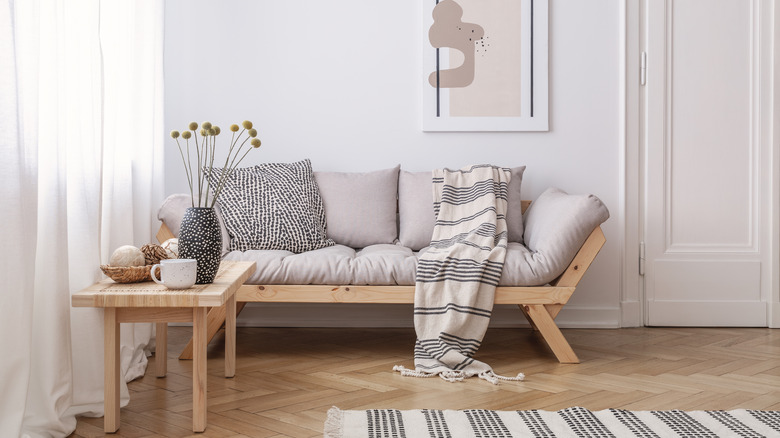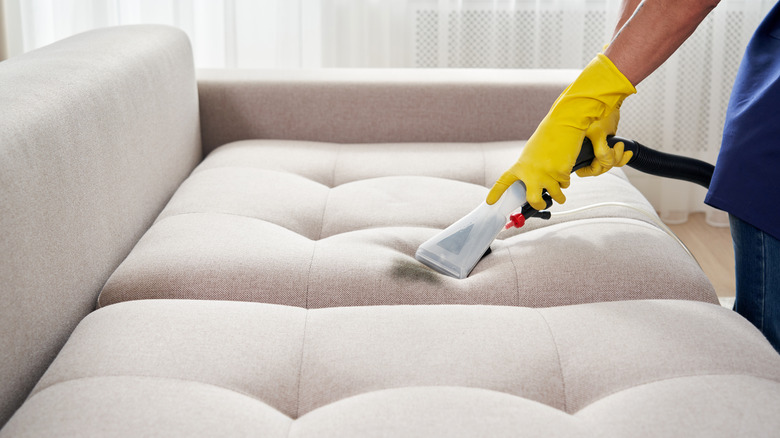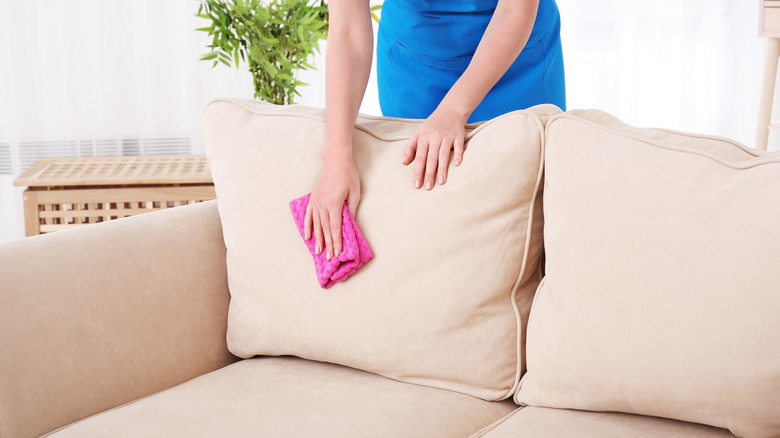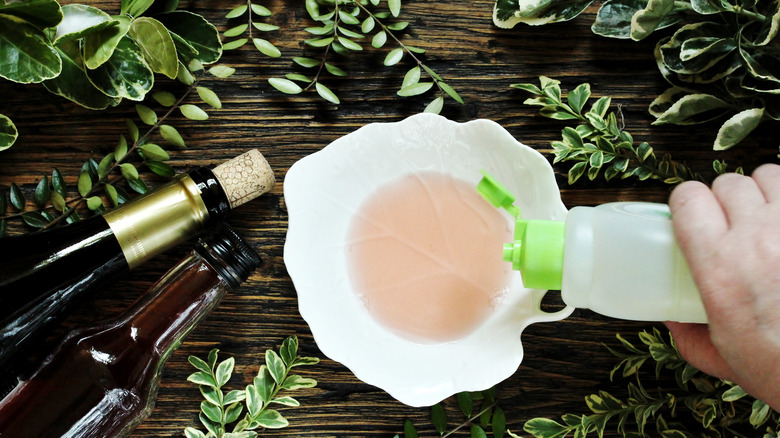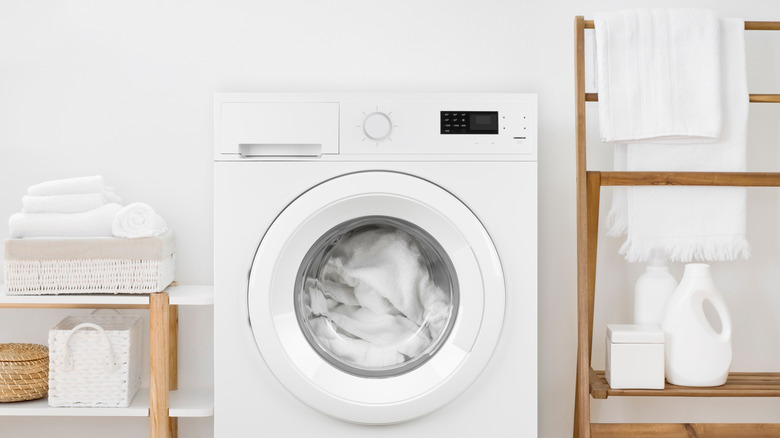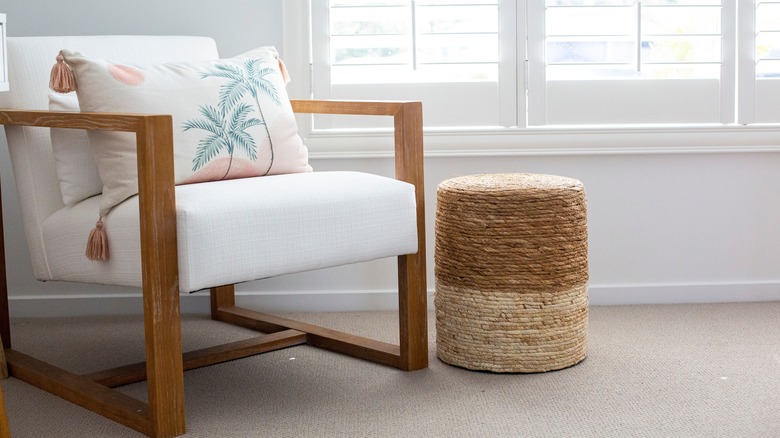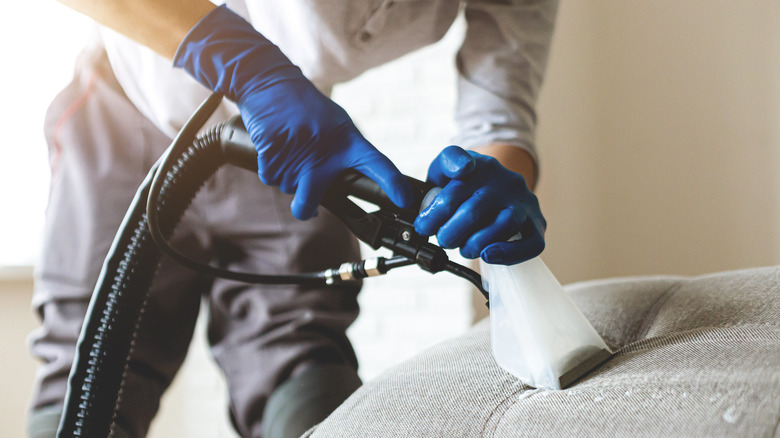Best Ways To Clean Linen Furniture
If you're looking to purchase new furniture or reupholster what you already have, you may have come across linen furniture, such as couches, armchairs, pillows, and throws. Linen may seem like a counterintuitive material for furniture you frequently lounge on, but it is superior to traditional upholstery fabrics in a lot of areas.
Linen, which is made from flax seed, is a soft, easy to clean, and durable material, according to World Linen. Additionally, linen is an incredibly environmentally friendly option, as flax doesn't require that much water to grow, and doesn't require a lot of harmful chemicals. Linen is also hypoallergenic and moisture resistant. That being said, linen is not dirt proof, nor is it immune to spills and other general wear and tear. Thankfully, cleaning linen is quite easy and straightforward, but you need to know what to do ahead of time to avoid shrinking the fabric or otherwise permanently ruining it.
1. Vacuum regularly
One of the most effective ways of preventing linen from getting so dirty that a professional needs to get involved is just to maintain it with a simple cleaning routine. According to Linen Beauty, one of the best ways to keep your linen furniture looking bright and beautiful is to vacuum it regularly.
Those with pets and children will want to vacuum very frequently, as a build-up of dirt, sweat, and hair will very quickly dull the appearance of your linen furniture. Simply use the handheld attachment of your vacuum and go over the upholstery, paying special attention to anywhere dirt and other debris can accumulate. Not only will your furniture always have a bright and clean look to it, but you'll be able to notice more serious or heavy-duty stains and dirt spots when you regularly vacuum it. For a fresh scent, consider spraying with a fabric spray from time to time after vacuuming.
2. Blot stains
While linen is highly desirable, it is not waterproof like leather, vinyl, or other spill-resistant counterparts. Food and drink stains are not a death sentence for linen, though, as long as you know what to do. The first and most important thing to know when it comes to dealing with stains on linen is that you should absolutely never rub or scrub the stains, warns Arlo & Jacob. Scrubbing will just lead to the stain traveling and setting deeper into the fabric. You also run the risk of stretching the fabric's delicate surface.
Instead, you should gently blot the surface. Use a clean, slightly dampened cloth to gently but firmly blot out the stain as soon as it occurs. If you have lighter colored linen, use a white or light cloth so the dye from the cloth doesn't transfer to the linen. If you have darker linen, work gently, as the dye from the fabric may lift.
3. Mild soap and vinegar
If the stain isn't coming out with just blotting, you can use white vinegar and mild soaps or detergents instead, recommends Lavender Hill Interiors. Before using either, spot test in an inconspicuous area to make sure neither will stain or damage the fabric. Darker and heavier-duty soaps may leave behind a color, so look for clear and gentle ones. Simply blot with a clean, light-colored cloth in the same way as you would with water.
These ingredients can also be used to deep clean your linen furniture, according to House Rituals. Begin by mixing a teaspoon of soap, a tablespoon of white vinegar, a teaspoon of baking soda, and about a cup of warm water together. This will create a fizzy, powerful natural cleaning mixture. Gently blot this onto the furniture, and let it dry for 20 minutes to an hour. Vacuum up the residue when done.
4. Wash covers and slips
If your furniture has a slipcover, one of the easiest ways to clean it is to simply wash it in the washing machine by following the care instructions on the label. However, the label often only has a letter or symbol indicating how to wash it, which can be hard to read and understand. Luckily, House Rituals has a breakdown of what the symbols mean. If the label says X, you can only vacuum it or have it professionally dry cleaned. If it says S, you can only use dry solvents to clean it. SW means you can use both solvents and wet clean, and W means you can only wet clean.
If you have an SW or W on your label, begin by removing the slipcover from the furniture and placing it in the washing machine. Add a mild, uncolored detergent and wash on a gentle and slow spinning cycle, no hotter than 30 degrees, but not too cold. Do not put it in the dryer, but, instead, let it mostly air dry away from the sun. When it's almost dry but still damp, put it back on your furniture to avoid shrinkage.
5. Stain proofing
While cleaning up stains from linen can be easy, what's easier is not having to deal with them in the first place. For this reason, Arlo & Jacob recommend applying a stain-resistant product that makes your fabric waterproof. While there are several professional products and services that may be offered with the purchase of your furniture or slipcover, there are also products that you can apply yourself, which are much more affordable.
3M's Scotchgard, can be found at almost any grocery store, home improvement store, and miscellaneous online retailers, and costs roughly $6 per 10 oz spray bottle. To apply, Scotchgard recommends first conducting a spot test by spraying the product on a hidden spot and rubbing it with a cloth — if there's dye transference, then it's not safe to use. When your furniture is clean and dry, shake the can and apply it lightly and slowly to every surface, let dry before using the furniture again, and reapply after every wash or once a year.
6. Hire a professional
If you have a particularly tough stain or a more disastrous mess, it may be time to bring in a professional. If your linen furniture has a removable slipcover, you can easily take this to your local dry cleaner to get it professionally cleaned. According to Comfy Living, upholstery items like this can cost anywhere from $20 to $40, depending on how large the cover is, how delicate it is, and how stained it is.
If you don't have a removable cover or don't want to go to a dry cleaner, you can also find a professional to come to your home. The price will depend upon the severity of the stain, the number of items being cleaned, and the service company hired. Shiny Carpet Cleaning estimates $100 to $200 per large couch, $60 to $70 per small couch, $40 to $50 per loveseat, and $30 to $40 per occasional chair or recliner.
7. DIY linen spray
Whether you live alone or have a large family and multiple pets dirtying up your linen furniture, body odors, food, and other environmental contaminants will inevitably get caught in the textile. Regularly vacuuming will certainly help your linen furniture smell as fresh as possible, but sometimes it will need a scent boost.
Since linen is an organic and slightly sensitive fabric, you want to make sure you use compatible materials to freshen its scent. While there are plenty of commercial linen sprays, you can also make your own using vodka and an essential oil of your choice, according to Kitchn. Simply combine 1.5 ounces of vodka (alternatively, you can use distilled water or rosewater), 1.5 ounces of water, and 30 drops of essential oil of. Add the ingredients to a spray bottle and shake well to combine, then spray on your furniture. Be careful to use lighter colored, undyed oils to prevent staining your furniture.
